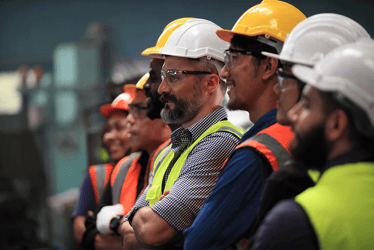The Packaging Industry's Sustainability Challenge: Why ERP Systems Are Essential for Success A straightforward guide to navigating sustainability regulations across folding carton, flexible...
Corrugated Process Control: Why Good Board Starts at the Single Facer
In the world of corrugated packaging, consistency is everything. Yet achieving that consistency is often far more complex than it appears.
We recently brought together some of the sharpest minds in corrugator process control for a global brainstorming session led by industry expert Fred Wiegmann.
What followed was a deep dive into what matters when it comes to producing quality board - and where the convezrsation needs to shift.
Contents
- Start Where It Matters Most: The Single Facer
- You Can’t Improve What You Don’t Measure
- Operator-Led, System-Supported
- Know Your Inputs: Why Paper Specs Still Matter
- From Warp to Waste: Taming the Hidden Costs
- The Road Ahead
- Want to dig deeper into best practices for corrugator process control?
Start Where It Matters Most: The Single Facer
If there's one universal truth that emerged during the session, it's this: quality starts at the single facer.
A tight temperature range (typically between 85°C and 95°C) on the liner is considered best practice. But it's not just about numbers. The placement of temperature sensors, the type of paper, and the ambient conditions - all play a role in achieving the right result.
As Fred put it, "There are a thousand and one ways to make flat board. But only one is the right way."
Regional variables further complicate matters. In high-altitude regions like Mexico City, where the boiling point of water is lower, plants must run cooler. Flexibility, backed by understanding, is key.
You Can’t Improve What You Don’t Measure
Board testing remains one of the most overlooked elements of process control. It's still a subjective process in too many plants, which is a problem.
"If you don’t measure, you just don’t know if it’s good quality board or not," said one of our team members. It's a sentiment echoed across the group.
Objective, real-time data collection - including moisture, flatness, and temperature before and after key stages - is essential. When coupled with AI-driven self-learning systems, this data can drive powerful outcomes, automating recipe adjustments and improving consistency.
Operator-Led, System-Supported
Automation alone won’t solve process variability. It has to be used wisely.
Our team was unanimous: the operator is central to performance. A system like Escada provides the intelligence and automation, but it requires knowledgeable, trained people to guide and interpret that data.
"It’s like cruise control," Fred explained. "The system helps, but you’re still in control."
That’s where intelligent speed control and historical data-driven targets come into play, helping plants find the sweet spot between quality and efficiency.
Know Your Inputs: Why Paper Specs Still Matter
Paper variability remains one of the industry's biggest hidden costs. Despite this, most plants don’t test incoming reels.
Our team has seen firsthand how inconsistent moisture, poor storage, and lack of testing can derail even the best-controlled systems. Performance and productivity suffer when price becomes the sole driver of procurement decisions.
"You need to know what you’re putting into the machine," Fred emphasized. "It’s not just steam and glue - it’s paper."
Even simple testing methods or using supplier-provided specs can dramatically improve control and reduce troubleshooting.
From Warp to Waste: Taming the Hidden Costs
Warp is often seen as a symptom to treat at the end of the process. But by the time the board hits the laser bar, it’s often too late.
Warp control starts much earlier, with balanced temperature, moisture control, glue application, and contact time. A well-tuned system produces a board that's already flat before it reaches the profile bar.
Process control systems like Escada don’t just improve performance - they expose mechanical issues that might otherwise go undetected. That’s why so many customers find themselves fixing machines after installing automation. The system doesn't just run better - it shows you where the problems are.
The Road Ahead
The corrugated industry faces fundamental challenges: raw material volatility, an ageing workforce, and growing pressure for sustainability and efficiency. But there’s also opportunity.
Smarter systems. Better data. Trained people.
When you combine these elements, you build not just a better board but a better business.
Want to dig deeper into best practices for corrugator process control?
Look out for our upcoming webinar series, where we’ll unpack these topics with real-world examples and expert insight.




